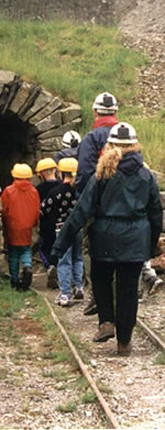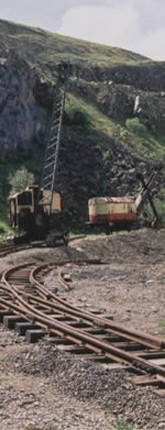The History Of Threlkeld Quarry & Mining Museum
Threlkeld quarry was opened in the 1870’s by Mr H Harkewitz, a man of German descent, to supply railway ballast to the Penrith-Keswick line. Initial output was a few hundred tons per year, but by 1894 this had risen to 80,000 tons to satisfy demand. The stone was used by the Manchester Corporation Waterworks for their Thirlmere scheme, for railway ballast for the Crewe-Carlisle line, for roadstone, kerbing and for facing buildings with dressed stone. Unlike pink Shap granite, Thelkeld granite is not suitable for polishing and decorative use.
Harkewitz controlled the quarry until 1892 when he formed the Threlkeld Granite Co. With other directors, and also established a precast concrete works to produce the Thelkeld concrete flagstones, which were used in many Northern towns. They were made in the flagsheds which were refurbished recently and now function as the Blencathra Business Centre, just below the entrance to the Museum.
In 1936 the company amalgamated with the Cumberland Granite Co. Of Embleton to form the Keswick Granite Co. At the time, Embleton was more profitable and Threlkeld quarry was closed in 1937. However, it was re-opened in 1949 after complete modernisation to begin its second, and final, lease of life.
Initially, rock was blasted loose from the quarry face by black powder (gunpowder) placed in deep drill holes at the base of the face, but in later years a mixture of fertiliser and diesel fuel was used. Both are relatively gentle explosives which shift out blocks of rock without shattering them. The broken rock was hand-loaded into wagons (‘tubs’) on a narrow gauge railway and fed to the crushers by gravity. The laden wagons pulled the empty ones back up to the face for refilling by means of a cable wound round a drum at the top of the incline. The primary and secondary crushers progressively reduced the size of the material. This was graded by passing through screens of different mesh sizes. At the face, the tubs were filled by hand at piecework rates; each man put his tally on his tub which was then removed and recorded by the tallyman at the original weighbridge (on the east side of the engine shed) as it passed by en route to the crushers.
To keep up with demand, more quarry faces had to be opened up. The railway, now operated by steam locomotives, was extended first to Spion Kop quarry and then to Bram Crag quarry further along St. John’s in the Vale and also down to the main line at the adjoining Threlkeld railway station.
In the reorganisation and modernisation which took place after the second world war, the railway was dismantled and rock was loaded at the quarry face by Ruston Bucyrus excavators into large tipper trucks which carried it up a ramp to the new crushing plant situated within the original quarry, whose output reached 500 tons per day in the 1950’s. Some of the output of granite chippings passed to the tarmacadam plant, where it was heated and dried in rotating ovens and then coated with hot tar. The tar plant was alongside the original crushing plant at the northern end of the engine shed, overlooking the most recent lorry weighbridge house alongside the entrance road to the Museum.
The quarry, then owned by ARC Ltd, finally closed in 1982 and demolition contractors removed everything saleable, leaving devastation all around. In 1992, Lakeland Mines and Quarries Trust finally negotiated a lease with the intention of developing a museum on the site, but in the meantime the ravages of weather and vandals had caused serious deterioration of the buildings.
Members of the Trust put in valiant work repairing buildings, removing or covering old plant foundations and landscaping, using vintage machinery. In 1995 the Trust was wound up, handing over the Museum’s future to the Museum Company (the trading arm of the Trust) which is now running the site. The Caldbeck Mining Museum joined the project in 1995, so that both quarrying and mining aspects of the local industrial past could be displayed.The final phase of quarry activity is represented by Ian Hartland’s unique working collection of Ruston Bucyrus excavators.The Museum is now also the home of the recently-formed Vintage Excavator Trust.
In September, 2004, the Caldbeck Collection was taken away, leaving space for a new development. Opened at Easter 2005, a completely new Interpretive Mining Section includes a new lighting, drilling and explosives room.




